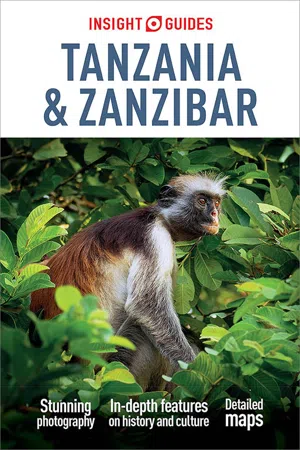
- 280 pages
- English
- ePUB (mobile friendly)
- Available on iOS & Android
Insight Guides Tanzania & Zanzibar (Travel Guide eBook)
About This Book
Insight Guides Tanzania and Zanzibar Travel made easy. Ask local experts.
Comprehensive travel guide packed with inspirational photography and fascinating cultural insights. From deciding when to go, to choosing what to see when you arrive, this guide to Tanzania and Zanzibar is all you need to plan your perfect trip, with insider information on must-see, top attractions like Mount Kilimanjaro, the Serengeti National Park and Lake Natron, and cultural gems like soaking in the laid-back Swahili atmosphere in Stone Town, chimp tracking in Mahale Mountains National Park and relaxing on the stunning white-sand beaches along the east coast of Zanzibar. Features of this travel guide to Tanzania and Zanzibar:
- Inspirational colour photography: discover the best destinations, sights and excursions, and be inspired by stunning imagery
- Historical and cultural insights: immerse yourself in Tanzania and Zanzibar's rich history and culture, and learn all about its people, art and traditions
- Practical full-colour maps: with every major sight and listing highlighted, the full-colour maps make on-the-ground navigation easy
- Editor's Choice: uncover the best of Tanzania and Zanzibar with our pick of the region's top destinations
- Key tips and essential information: packed full of important travel information, from transport and tipping to etiquette and hours of operation
- Covers: Dar es Salaam, the north coast and Usambara, Arusha and Kilimanjaro, the northern safari circuit, western and central Tanzania, southern parks and Tanzam Highway, Mbeya and Lake Nyasa, the south coast, Zanzibar and Pemba. About Insight Guides: Insight Guides is a pioneer of full-colour guide books, with almost 50 years' experience of publishing high-quality, visual travel guides with user-friendly, modern design. We produce around 400 full-colour print guide books and maps, as well as phrase books, picture-packed eBooks and apps to meet different travellers' needs. Insight Guides' unique combination of beautiful travel photography and focus on history and culture create a unique visual reference and planning tool to inspire your next adventure.
Frequently asked questions
Information
Table of contents
- How To Use This E-Book
- Texas’s Top 10 Attractions
- Editor’s Choice
- Introduction: The Stuff of Legends
- People
- Decisive Dates
- The Earliest Inhabitants
- Swahili Traders
- Imperial Ambitions
- The Colonial Era
- Independence
- Music, Dance and Art
- The Lie of the Land
- Safari
- Mammals
- Insight: Endangered and endemic wildlife
- Birds
- Tanzania’s Reptiles
- Introduction: Places
- Introduction: Dar ES Salaam
- Introduction: The North Coast and Usambara
- Introduction: Arusha and Kilimanjaro
- Introduction: The Northern Safari Circuit
- Insight: Maasai: nomads of the plains
- Introduction: Western and Central Tanzania
- Introduction: Southern Parks and Tanzam Highway
- Introduction: Mbeya and Lake Nyasa
- Introduction: The South Coast
- Introduction: Zanzibar and Pemba
- Insight: The Swahili
- Transportation
- A-Z: A Handy Summary of Practical Information
- Language
- Further Reading